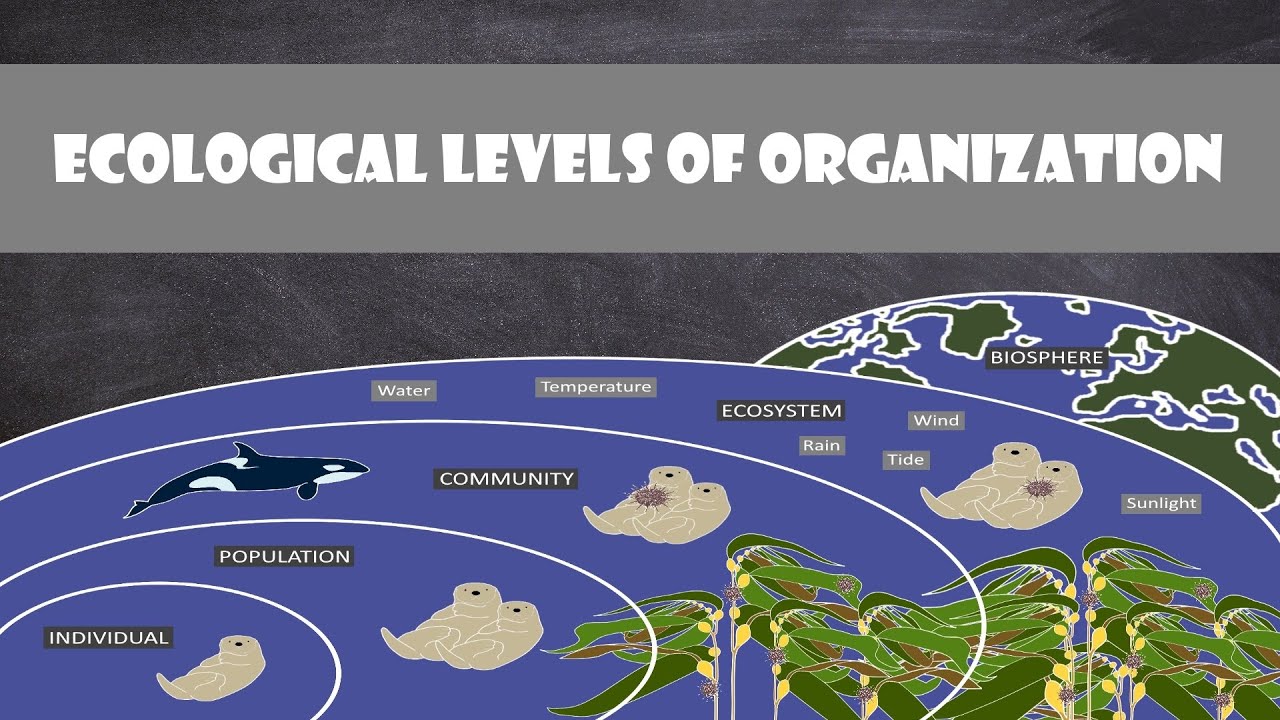
Ecology is a fascinating field of study that explores the interactions among living organisms and their environment. At its core, ecology aims to understand the complex relationships between organisms and their surroundings, providing valuable insights into the delicate balance that sustains life on our planet. One of the fundamental concepts in ecology is the levels of organization, which categorize the different ecological units based on their hierarchical structure.
In this article, we will delve into the enigmatic facts about ecology levels of organization, shedding light on the intricate systems that govern the natural world. From individual organisms to entire ecosystems, each level of organization plays a crucial role in shaping the biodiversity and functioning of our planet. So, buckle up and prepare to embark on a journey through the diverse dimensions of ecological organization, where you’ll discover fascinating facts that will inspire awe and deepen your appreciation for the intricate web of life.
Key Takeaways:
- The Biosphere is the highest level of ecology, encompassing all life on Earth, from oceans to deserts. Understanding these levels helps us protect our planet’s diverse ecosystems.
- Climate change and conservation are crucial for ecological balance. By preserving biodiversity and adopting sustainable practices, we can ensure the health of ecosystems for future generations.
The Biosphere is the highest level of organization in ecology
At the highest level of ecological organization, the Biosphere encompasses all living organisms on Earth and the environments in which they exist. It includes everything from the vast oceans and lush forests to the deserts and polar regions. The Biosphere is a complex and interconnected system that sustains life on our planet.
An individual organism is the lowest level of organization
An individual organism, such as a plant or an animal, is the basic unit of life in ecology. Each organism has its own set of characteristics and functions within its particular environment. Whether it’s a towering oak tree or a tiny microorganism, every individual plays a vital role in maintaining the balance of ecosystems.
Populations consist of individuals of the same species
A population refers to a group of individuals of the same species that live in the same area and can potentially interact with one another. These interactions, such as reproduction and competition for resources, shape the dynamics of population growth and distribution.
Communities are composed of multiple populations
A community comprises all the populations of different species that coexist and interact within a particular habitat. For example, a forest community may consist of trees, shrubs, insects, birds, and mammals, each relying on one another for survival. The interactions between species within a community are crucial for maintaining biodiversity and ecosystem stability.
Ecosystems involve communities and their physical environment
An ecosystem refers to a specific area where living organisms interact with each other and with their physical surroundings. It encompasses both the biotic (living) and abiotic (non-living) components, such as soil, water, air, and climate, that influence the functioning of the community. Ecosystems can range from a small pond to a vast coral reef or a sprawling grassland.
Biomes are large-scale ecosystems with common characteristics
Biomes are major ecological regions characterized by distinctive climate patterns, vegetation, and animal life. Examples of biomes include tropical rainforests, deserts, tundras, and grasslands. These vast areas play a crucial role in shaping global climate patterns and supporting diverse ecosystems.
The hydrosphere is the water component of the Earth
The hydrosphere refers to all the water on the Earth’s surface, including oceans, rivers, lakes, glaciers, and groundwater. Water is essential for sustaining life and plays a crucial role in regulating climate, nutrient cycling, and habitat availability for aquatic organisms.
The lithosphere is the land component of the Earth
The lithosphere comprises the solid outer layer of the Earth’s crust, including rocks, minerals, and landforms. It provides a physical foundation for ecosystems and supports plant roots, burrows, and habitats for terrestrial organisms. The lithosphere also plays a vital role in the cycling of nutrients and minerals.
The atmosphere is the gaseous envelope surrounding the Earth
The atmosphere is a layer of gases that surrounds the Earth, providing vital components for life, such as oxygen and carbon dioxide. It acts as a protective shield against harmful radiation and plays a crucial role in regulating climate and weather patterns. The atmosphere is home to various organisms, including birds, insects, and microorganisms that dwell in the air.
Ecotones are transition areas between different ecosystems
Ecotones are transitional zones where two different ecosystems meet. They are characterized by a mix of species from both ecosystems and often have unique environmental conditions. Ecotones can be seen at the edge of a forest and a grassland or where a river meets the ocean. These areas are important for biodiversity and facilitate the exchange of energy and resources between ecosystems.
The trophic levels represent feeding positions in a food chain
Trophic levels describe the different positions or levels in a food chain or food web. Producers, such as plants, occupy the first trophic level as they convert sunlight into energy through photosynthesis. Herbivores, carnivores, and omnivores are found in higher trophic levels, representing the transfer of energy from one organism to another. At each trophic level, energy is lost as heat, limiting the number of organisms that can be supported in an ecosystem.
The energy pyramid represents the flow of energy in an ecosystem
An energy pyramid is a graphical representation of the flow of energy through different trophic levels in an ecosystem. It demonstrates that energy decreases as it moves up the food chain, with the majority of energy being lost as heat. This pyramid shape illustrates the dependence of higher-level consumers on a larger base of producers.
Biogeochemical cycles involve the cycling of nutrients in ecosystems
Biogeochemical cycles, such as the carbon, nitrogen, and phosphorus cycles, involve the movement of essential nutrients through living organisms, the atmosphere, the lithosphere, and the hydrosphere. These cycles are essential for the recycling and availability of nutrients, ensuring the sustainability of ecosystems and supporting life.
Symbiotic relationships involve interactions between different species
Symbiotic relationships refer to close and long-term interactions between different species. These interactions can be mutualistic, where both species benefit, such as the relationship between bees and flowers. They can also be parasitic, where one species benefits at the expense of the other, such as ticks feeding on the blood of mammals. Symbiotic relationships play a crucial role in shaping ecological communities.
Succession is the gradual change of an ecosystem over time
Succession is a process in which an ecosystem undergoes a series of changes in species composition and structure over time. Primary succession occurs in newly formed or bare areas, such as volcanic islands, while secondary succession occurs in areas that have been disturbed, such as after a fire or clear-cutting. Succession is essential for the renewal and regeneration of ecosystems.
Climate change poses significant challenges to ecological systems
Climate change, caused primarily by human activities, is altering temperature patterns, weather events, and natural habitats worldwide. These changes have far-reaching consequences for ecological systems, including shifts in species distributions, disruptions in food webs, and increased vulnerability to extreme events. Adapting to and mitigating the impacts of climate change is crucial for the survival of ecosystems and the species within them.
Conservation and sustainable practices are vital for ecological balance
Conservation efforts, including the protection of natural habitats, endangered species, and the sustainable use of resources, are essential for maintaining ecological balance. By preserving biodiversity and adopting sustainable practices, we can ensure the long-term health and resilience of ecosystems for future generations.
The study of ecology deepens our understanding of the natural world
Ecology plays a crucial role in unraveling the intricate connections between living organisms and their environment. By studying ecological principles and processes, we gain insights into how ecosystems function and how to mitigate environmental problems. The knowledge gained from ecological research helps inform conservation strategies and sustainable practices, guiding our interactions with the natural world.
Conclusion
In conclusion, the ecology levels of organization are a fascinating aspect of biology that involves the study of how living organisms interact with their environment. From individual organisms to entire ecosystems, each level plays a crucial role in maintaining the balance and sustainability of our planet.Throughout this article, we have explored 18 enigmatic facts about the various levels of organization in ecology. We have learned about the intricate relationships between organisms and their surroundings, the importance of biodiversity, and the delicate balance that exists within ecosystems.Understanding the levels of organization in ecology is essential for scientists, conservationists, and individuals alike. It helps us comprehend the interconnectedness of all living things and highlights the significance of preserving our natural resources.By deepening our knowledge of ecology, we can strive towards creating a more sustainable future, where humans and the environment coexist harmoniously.
FAQs
1. What are the different levels of organization in ecology?
The different levels of organization in ecology are individual, population, community, ecosystem, biome, and biosphere.
2. How does the individual level of organization relate to ecology?
The individual level of organization focuses on the interactions between an organism and its environment, including its behaviors and physiological processes.
3. What is a population in ecology?
A population refers to a group of individuals of the same species living in the same area and interacting with each other.
4. How does a community differ from a population?
A community consists of multiple populations of different species living in the same area and interacting with each other.
5. What is an ecosystem?
An ecosystem is a community of organisms interacting with each other and their physical environment, including the non-living elements such as air, water, and soil.
6. What is a biome?
A biome refers to a large geographic area with similar climatic conditions, which determines the types of plants and animals that can survive there.
7. What is the biosphere?
The biosphere encompasses all the ecosystems on Earth and includes the interactions between living organisms and their environments.
8. Why is biodiversity important in ecology?
Biodiversity is important in ecology as it contributes to the stability, health, and resilience of ecosystems. It supports various ecological processes and provides ecosystem services.
9. How can human activities impact ecology levels of organization?
Human activities, such as deforestation, pollution, and climate change, can disrupt ecological balance, leading to loss of biodiversity, habitat destruction, and other adverse effects on ecosystems.
10. What can individuals do to help preserve ecology levels of organization?
Individuals can contribute to the preservation of ecology by practicing sustainable behaviors, supporting conservation efforts, and spreading awareness about the importance of protecting the environment.
Ecology's levels of organization, from the minuscule to the magnificent, weave a tapestry of life on Earth. Dive deeper into nature's mysteries by exploring population dynamics, unraveling the secrets of organism structures, and discovering the wonders of diverse habitats. Each thread in this ecological web tells a story waiting to be uncovered, inviting curious minds to embark on a journey of discovery through the intricate layers of our planet's biodiversity.
Was this page helpful?
Our commitment to delivering trustworthy and engaging content is at the heart of what we do. Each fact on our site is contributed by real users like you, bringing a wealth of diverse insights and information. To ensure the highest standards of accuracy and reliability, our dedicated editors meticulously review each submission. This process guarantees that the facts we share are not only fascinating but also credible. Trust in our commitment to quality and authenticity as you explore and learn with us.


